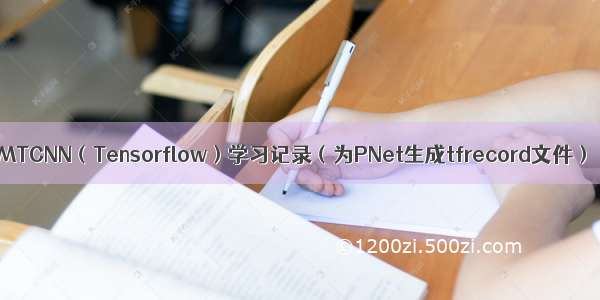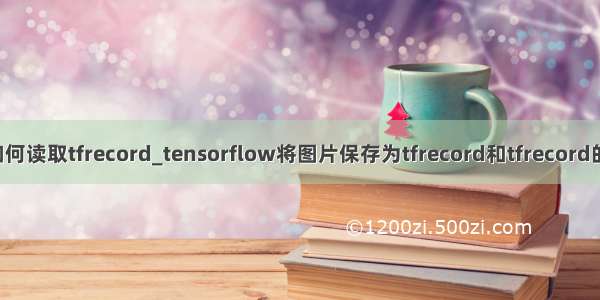
Tensorflow—TFRecord文件生成与读取
微信公众号:幼儿园的学霸
个人的学习笔记,关于OpenCV,关于机器学习, …。问题或建议,请公众号留言;
目录
文章目录
Tensorflow—TFRecord文件生成与读取目录一.为什么使用TFRecord二.TFRecord文件生成1.TFRecord生成器2.Example模块3.生成TFRecord文件完整代码实例三.TFRecord文件读取1.基本流程2.代码示例参考资料一.为什么使用TFRecord
关于 tensorflow 读取数据, 官网提供了3种方法:
Feeding: 在tensorflow程序运行的每一步, 用python代码在线提供数据。Reader : 在一个计算图(tf.graph)的开始前,将文件读入到流(queue)中。在声明tf.variable变量或numpy数组时保存数据。受限于内存大小,适用于数据较小的情况。
我们在刚学习Tensorflow时,几乎所有的例子都是使用第一种或第三种方法,因为例子中的数据量都比较少,而当数据量比较大时,由于这些文件被散列存着,这样不仅占用磁盘空间,并且在被一个个读取的时候会非常慢,繁琐,占用大量内存空间(有的大型数据不足以一次性加载),效率比较低。此时,第二种方法就会发挥巨大的作用,因此它存储的是二进制文件,PC读取二进制文件是比读取格式文件要快的多。
TFRecords是TensorFlow中的设计的一种内置的文件格式,它是一种二进制文件。其具有以下优点:
统一不同输入文件的框架。它是更好的利用内存,更方便复制和移动。TFRecord压缩的二进制文件采用protocal buffer序列化,只占用一个内存块,只需要一次性加载一个二进制文件的方式即可,简单,快速,尤其对大型训练数据很友好。而且当我们的训练数据量比较大的时候,可以将数据分成多个TFRecord文件,来提高处理效率。是用于将二进制数据和标签(训练的类别标签)数据存储在同一个文件中
二.TFRecord文件生成
在将其他数据生成为TFRecords文件存储的时候,需要经过两个步骤:
建立TFRecord生成器(存储器)构造每个样本的Example模块
1.TFRecord生成器
writer = tf.python_io.TFRecordWriter(record_path)#for :writer.write(tf_example.SerializeToString())#...writer.close()
此处的writer就是我们的TFRecord生成器,输出参数record_path为我们将要生成的TFRecord文件的存储路径。
构建完毕TFRecord文件生成器后就可以调用生成器的write()方法向文件中写入一个字符串记录(即一个样本),不断的调用该方法以将每一个样本存储于生成器中,最后调用close()函数来关闭文件的写操作。
其中writer.write()的参数为一个序列化的Example,通过Example.SerializeToString()来实现,它的作用是将Example中的map压缩为二进制,节约大量空间。而Example是通过Example模块生成的。
2.Example模块
首先们来看一下Example协议块是什么样子的。
message Example {Features features = 1;};message Features {map<string, Feature> feature = 1;};message Feature {oneof kind {BytesList bytes_list = 1;FloatList float_list = 2;Int64List int64_list = 3;}};
从定义中可以看出tf.train.Example是以字典的形式存储数据格式,string为字典的key值,字典的属性值有三种类型:bytes、float、int64。详解如下:
(1)tf.train.Example(features = None)
写入tfrecords文件features : tf.train.Features类型的特征实例return : example协议格式块
(2)tf.train.Features(feature = None)
构造每个样本的信息键值对feature : 字典数据,key为要保存的名字,value为tf.train.Feature实例return : Features类型
(3)tf.train.Feature(**options)
options可以选择如下三种格式数据:
bytes_list = tf.train.BytesList(value = [Bytes])int64_list = tf.train.Int64List(value = [Value])float_list = tf.trian.FloatList(value = [Value])
那我们如何构造一个tf_example呢?下面有一个简单的例子
def int64_feature(value):return tf.train.Feature(int64_list=tf.train.Int64List(value=[value]))def int64_list_feature(value):if not isinstance(value, collections.Iterable):value = [value]return tf.train.Feature(int64_list=tf.train.Int64List(value=value))def bytes_feature(value):return tf.train.Feature(bytes_list=tf.train.BytesList(value=[value.tobytes()]))tf_example = tf.train.Example(#key-value形式features=tf.train.Features(feature={'image/image': bytes_feature(image),'image/shape': int64_list_feature(list(image.shape)),"bbox/xmins": int64_list_feature(xmins),"bbox/ymins": int64_list_feature(ymins),"bbox/xmaxs": int64_list_feature(xmaxs),"bbox/ymaxs": int64_list_feature(ymaxs),'image/classes': int64_list_feature(classes),}))
3.生成TFRecord文件完整代码实例
代码及图片路径:/leonardohaig/yolov3_tensorflow/blob/master/generate_tfrecord.py
1)准备图片文件夹存放图片,此处我采用了小浣熊数据集
2)准备标签文件,文件格式如下:
xxx/xxx.jpg 18.19,6.32,424.13,421.83,20 323.86,2.65,640.0,421.94,20 xxx/xxx.jpg 48,240,195,371,11 8,12,352,498,14# image_path x_min, y_min, x_max, y_max, class_id x_min, y_min ,..., class_id
每一行表示图像路径,矩形框的左上顶点、右下顶点坐标,该矩形框类别 矩形框的左上顶点、右下顶点坐标,该矩形框类别 …
这两份文件分别为训练集和验证集。在该项目中已制作好,位于data/classes文件夹中,分别为data/classes/train_yoloTF.txt和test_yoloTF.txt
3)生成TFRecord文件,generate_tfrecord.py
import osimport collectionsimport sysimport cv2import tensorflow as tfdef int64_feature(value):return tf.train.Feature(int64_list=tf.train.Int64List(value=[value]))def int64_list_feature(value):if not isinstance(value, collections.Iterable):value = [value]return tf.train.Feature(int64_list=tf.train.Int64List(value=value))def bytes_feature(value):return tf.train.Feature(bytes_list=tf.train.BytesList(value=[value.tobytes()]))def create_tf_example(annotation):'''创建一条tf_example格式的数据:param annotation:list类型,一行label标签,内容:图片路径,目标位置,类别,....:return:'''line = annotation.split()image_path = line[0]assert os.path.exists(image_path),'{} not exist !'.format(image_path)xmins = []ymins = []xmaxs = []ymaxs = []classes = []for content in line[1:]:content = list(map(int,content.split(','))) #将其转换为int listxmins.append(content[0])ymins.append(content[1])xmaxs.append(content[2])ymaxs.append(content[3])classes.append(content[4])image = cv2.imread(image_path,cv2.IMREAD_UNCHANGED)image = cv2.resize(image, (413, 413), interpolation=cv2.INTER_LINEAR)tf_example = tf.train.Example(#key-value形式features=tf.train.Features(feature={'image/image': bytes_feature(image),'image/shape': int64_list_feature(list(image.shape)),"bbox/xmins": int64_list_feature(xmins),"bbox/ymins": int64_list_feature(ymins),"bbox/xmaxs": int64_list_feature(xmaxs),"bbox/ymaxs": int64_list_feature(ymaxs),'image/classes': int64_list_feature(classes),}))#print(tf_example)return tf_exampledef generate_tfrecord(labelFile, recordPath):''':param labelFile: label file 文件路径:param recordPath: 创建的TFRecord文件存储路径:return:'''file_dir = os.path.dirname(os.path.abspath(recordPath))# 获取当前文件所在目录的绝对路径assert os.path.exists(file_dir),'{} not exist !'.format(file_dir)with open(labelFile,'r') as file:# writer = tf.python_io.TFRecordWriter(recordPath)writer = tf.io.TFRecordWriter(recordPath)for line in file.readlines():# annotation = line.split('\n') # 去除末尾的'\n'tf_example = create_tf_example(line)writer.write(tf_example.SerializeToString())writer.close()return Trueif __name__ == '__main__':# 生成TFRecords文件generate_tfrecord('/home/liheng/PycharmProjects/yolov3_tensorflow/data/classes/test_yoloTF.txt','./test.tfrecord')
Note:大多数情况下图片进行encode编码保存在tfrecord时 是一个一维张量,shape为
(1,),因此有必要将尺寸信息保存下来,以便于恢复图片
三.TFRecord文件读取
1.基本流程
文件读取和文件创建的流程基本相同,只是中间多了一步解析过程。
1)将TFRecord文件test.record文件读入到文件队列中,如下所示:
filename_queue = tf.train.string_input_producer([tfrecords_filename])
使用tf.train.string_input_producer生成一个输入文件队列。这里我们的输入列表文件只有一个[path],而如果当训练数据比较大时,就需要将数据拆分多个TFRecord文件来提高处理效率。
例如,Cifar10的例子中,将训练集数据拆分为5个bin文件以提高文件处理效率,Cifar10例子使用下面方式获取所有的训练集输入文件列表,而Tensorflow既然让我们将训练数据拆分为多个TFRecord文件,那么它也提供函数tf.train.match_filenames_once,通过正则表达式获取某个目录下的输入文件列表。
filenames = [os.path.join(data_dir, 'data_batch_%d.bin' % i)for i in xrange(1, 6)]filenames =tf.train.match_filenames_once('data_batch_×')
2)通过TFRecordReader读入生成的文件队列
reader = tf.TFRecordReader()_, serialized_example = reader.read(filename_queue) #返回文件名和文件
3)通过解析器tf.parse_single_example将我们的example解析出来
当然,也可以采用tf.parse_example来解析,和tf.parse_single_example区别在于后者解析的是单个example.
2.代码示例
代码路径:/leonardohaig/yolov3_tensorflow/blob/master/generate_tfrecord.py
def read_tfrecord(batchsize, recordFileList):'''从TFRecords文件当中读取图片数据(解析example):param batchsize::param recordFileList: TFRecord file文件列表,list类型:return:'''assert isinstance(recordFileList, collections.Iterable),'param recordFileList need type list!'# 1.构造文件队列filename_queue = tf.train.string_input_producer(recordFileList,num_epochs=None, shuffle=True) # 参数为文件名列表# 2.构造阅读器reader = tf.TFRecordReader()_, serialized_example = reader.read(filename_queue) # 返回文件名和文件# 3.批处理,此处批处理提前放置batch = tf.train.shuffle_batch([serialized_example],batch_size=batchsize, capacity=batchsize * 5, min_after_dequeue=batchsize * 2,num_threads=1)# 4.解析协议块,返回的值是字典.采用tf.parse_example,其返回的Tensor具有batch的维度_feature = {'image/image': tf.io.FixedLenFeature([], tf.string),'image/shape': tf.io.FixedLenFeature([3], dtype=tf.int64),'bbox/xmins': tf.io.VarLenFeature(dtype=tf.int64),'bbox/ymins': tf.io.VarLenFeature(dtype=tf.int64),'bbox/xmaxs': tf.io.VarLenFeature(dtype=tf.int64),'bbox/ymaxs': tf.io.VarLenFeature(dtype=tf.int64),'image/classes': tf.io.VarLenFeature(dtype=tf.int64)}features = tf.io.parse_example(batch,features=_feature)# 得到图片shape信息image_shape = features['image/shape']# 处理图片数据,由于是一个string,要进行解码, #将字节转换为数字向量表示,字节为一字符串类型的张量# 如果之前用了tostring(),那么必须要用decode_raw()转换为最初的int类型# decode_raw()可以将数据从string,bytes转换为int,float类型的image_raw = features['image/image']# Get the image as raw bytes.image_tensor = tf.decode_raw(image_raw, tf.uint8)# Decode the raw bytes so it becomes a tensor with type.# 转换图片的形状,此处需要用动态形状进行转换image_tensor = tf.reshape(image_tensor,shape=[batchsize,image_shape[0][0],image_shape[0][1],image_shape[0][2]])image_tensor = tf.image.convert_image_dtype(image_tensor,dtype=tf.float32) # The type is now uint8 but we need it to be float.bbox_xmins = features['bbox/xmins']bbox_ymins = features['bbox/ymins']bbox_xmaxs = features['bbox/xmaxs']bbox_ymaxs = features['bbox/ymaxs']bbox_classes = features['image/classes']bbox_classes = tf.cast(bbox_classes,dtype=tf.int32)bbox_xmins = tf.sparse.to_dense(bbox_xmins)bbox_ymins = tf.sparse.to_dense(bbox_ymins)bbox_xmaxs = tf.sparse.to_dense(bbox_xmaxs)bbox_ymaxs = tf.sparse.to_dense(bbox_ymaxs)bbox_classes = tf.sparse.to_dense(bbox_classes)return image_tensor,bbox_xmins,bbox_ymins,bbox_xmaxs,bbox_ymaxs,bbox_classesif __name__ == '__main__':# # 生成TFRecords文件# generate_tfrecord('/home/liheng/PycharmProjects/yolov3_tensorflow/data/classes/test_yoloTF.txt',# './test.tfrecord')# 从已经存储的TFRecords文件中解析出原始数据image_tensor, bbox_xmins, bbox_ymins, bbox_xmaxs, bbox_ymaxs, bbox_classes = read_tfrecord(4,['./test.tfrecord'])with pat.v1.Session() as sess:sess.run(pat.v1.global_variables_initializer())# 线程协调器coord = tf.train.Coordinator()# 开启线程thread = tf.train.start_queue_runners(sess, coord)for i in range(5):_image_tensor, _bbox_xmins, _bbox_ymins, _bbox_xmaxs,\_bbox_ymaxs, _bbox_classes = sess.run([image_tensor,bbox_xmins,bbox_ymins,bbox_xmaxs,bbox_ymaxs,bbox_classes])print(i,_image_tensor.shape)#print(_bbox_xmins)cv2.imshow('image0', _image_tensor[0])cv2.imshow('image1', _image_tensor[1])cv2.waitKey(0)cv2.destroyAllWindows()# 回收线程coord.request_stop()coord.join(thread)
参考资料
1.Tensorflow(一) TFRecord生成与读取.
2.TensorFlow基础5:TFRecords文件的存储与读取讲解及代码实现
3.Tensorflow针对不定尺寸的图片读写tfrecord文件总结
下面的是我的公众号二维码图片,欢迎关注。














